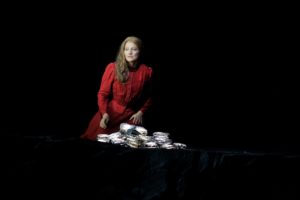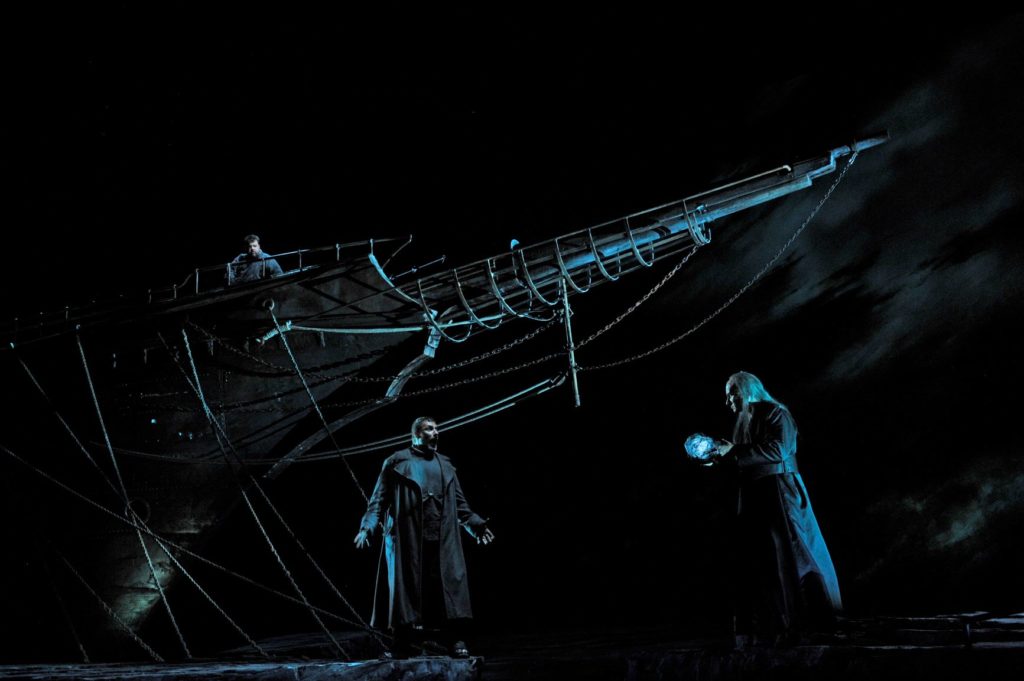
Festival D’Opéra de Québec 2019 Review: Der Fliegende Holländer
Johanni van Oostrum Shines in François Girard’s Visually Arresting New Production
By Sebastien Turgeon(Credit: Louise Leblanc)
Premiering in 1843 prior to Richard Wagner’s 30th birthday, “Der Fliegende Holländer” was the successful outcome of a frustrating period in the life of the young composer. At the bitter end of his tenure as musical director of a theater in Riga, Wagner left for Paris with his wife. After an illegal crossing into Prussia followed by some complications, they ended up leaving for London.
During the crossing, their ship was caught in a storm and it was forced towards the coast of Norway. It is during this journey that the composer would find inspiration for his first big breakthrough opera.
A New Production
For its 9th edition, the Festival d’Opéra de Québec co-produced “Der Fliegende Holländer” with the Metropolitan Opera, De Nederlandse Opera (Amsterdam), and the Abu Dhabi Festival. After a successful “Parsifal” in New York and Lyon, Canadian director François Girard chose to present a mostly realist and visually spectacular Flying Dutchman, with touches of symbolism and a somewhat subdued staging.
The evening’s curtain was the painting of the Dutchman, a giant eye, which reappears as a backdrop during the second act. In this conception of the work, Senta is constantly center stage and the focal point of the story, focusing on the girl’s dream rather than the supernatural aspect of the story. Thus this conceptual choice comes at the price of the character of the Dutchman, who is reduced to an older and desperate man rather than a mysterious, ghostly, scary and dominant figure.
John Macfarlane’s sets are beautiful and unobtrusive, at the service of the drama. In the first and last acts, Daland’s ship comes in from the left, opposite the rocky shore. The rocks remain for the second act and ropes come down from heaven, with the painting as a backdrop. The ropes not only facilitate the women’s spinning but symbolize their commitment to a conventional life.
All costumes are in shades of brown and grey, with the exception of Senta’s red dress. Here again, with his grey outfit, the Dutchman gets blended in with the others instead of standing out. The lighting and projections are spectacular and greatly contribute to the beauty of the production. Some discreet choreography by Carolyn Choa adds grace and purpose to the choruses and to the final scene.
The Focus of Attention
In the role of Senta, South African soprano Johanni van Oostrum rose to the occasion, both vocally and dramatically. Displaying a bright, attractive and penetrating full lyric spinto soprano, van Oostrum’s Senta was sensitive, strong, determined and appealing onstage and at the center of the evening’s best moments.
With the ballad, van Oostrum introduced us to a woman different than the others of the village and rejecting their conventional lives and duties. Taken slowly and introspectively, the ballad was a good vehicle for van Oostrum’s good breath control, very clean attacks, and her impressive range of dynamics.
Breaking apart from the other women for the last stanza of the ballad, van Oostrum came downstage and displayed very secure and powerful high notes. Senta had made her stance and nothing would stop her.
Later on at the end of her duet with the Dutchman and the following trio with Daland, van Oostrum was able to successfully navigate the treacherous high notes, without an out-of-tune or shrill sound. As a whole, her voice is very even throughout the register and always pierces through the orchestra. She is at her best in the middle voice where she is able to paint her words with very beautiful colors.

(Credit: Louise Leblanc)
A Downsized Dutchman
In the title role, Canadian baritone Gregory Dahl is a very capable singer. His baritone is bright rather than dark, strong but not large nor booming. Lacking the heft and darkness of a Wagnerian bass-baritone and coupled with a very static blocking, his singing and acting were subdued and he never became that commanding presence on stage. His Dutchman is suitably anguished and desperate, but his character is set, sung and played more as the complement to Senta’s centrality, than as the main character.
In the shorter role of Daland, German bass Andreas Bauer Kanabas was a revelation. He displayed a large and very beautiful instrument, signing with perfect style. His Daland was expressive, commanding, greedy and serious. A truly outstanding performance.
The role of Erik was taken by the excellent Canadian heldentenor Eric Laporte. In this fairly unrewarding part, Laporte displayed a bright and clear tenor, never shouting and capable of varying his dynamics. His tenor was powerful and ringing; not a note sounded strained or shrill. His Erik was likable, not a coward but more the voice of reason. He was dominant, a bit hot-headed and mostly desperate.
His second act duet with Senta was one of the stronger moments of the evening. It was a rare moment of extroverted passion and sparks flews between the singers. Very beautiful and committed singing ensued.
In the short role of Mary, Allyson McHardy had a strong and attractive stage presence, rather than the common matronly appearance, making Mary an example for the other women and counterbalancing Senta’s influence. Her lyrical mezzo was pleasant, well-controlled and forceful.
In the role of the Steersman, Eric Thériault displayed a robust and lyrical tenor, although with some constricted high notes and occasional breath control issues. He sang with appropriate German style and easily carried out his scene.
More Weber Than Wagner
In the pit, Jacques Lacombe conducted a romantic reading of the score, more in the style of Weber and Beethoven than the late Wagner, which is appropriate. His conducting was fast paced, precise, suitably loud, if perhaps lacking a bit of spontaneity. A good support for his singers and for the chorus, he was able to maintain the musical tension during the uninterrupted two hours and fifteen minutes. The Orchestre symphonique de Québec played very well and very accurately, if not for a slight lack of richness in their sound.
The chorus of the Opéra de Québec was in great form. In the first act, the men sang with gusto and aplomb. In the second act, the women were riveting, singing with delicate sensitivity and playfulness. Disappointingly, recordings of the men’s chorus were used instead of live voices for the Dutchman sailors chorus in the third act. In addition to the distraction and the artificial quality of the sound, this decision gave an otherworldly feeling to the unseen chorus, fittingly scary, but it did not correspond to conception of the character of the Dutchman, his lack of dominance and of otherworldly qualities.
All-in-all, it was a very enjoyable evening at the opera and a very good quality performance. This new production is visually arresting, often with a cinematographic look, but lacks a more defined staging. Undoubtedly the production will continue to evolve until it is presented on the Metropolitan Opera stage next year.
The performance was musically very good, with some very fine singing, especially by Andreas Bauer Kanabas and Eric Laporte. But ultimately, Johanni van Oostrum was able to carry the performance and she triumphed.


